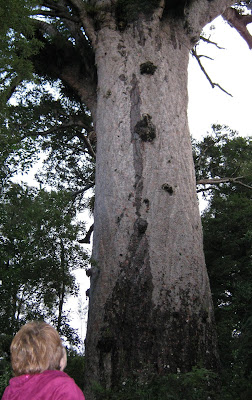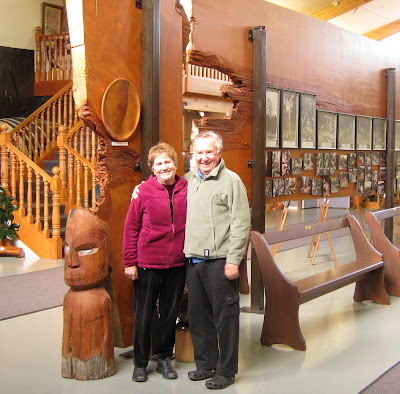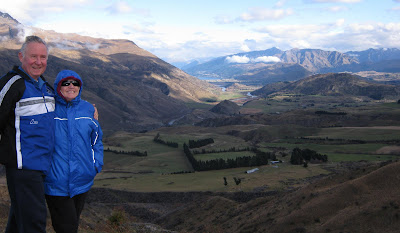



















As the saying goes....”If I were a glow-worm, I never would be glum: for how can I be gloomy, when the sun shines out my .....”
We came to the Waitomo Caves which are known not only for the fantastic caves and caverns with the usual stalagmites and stalactites, but also for the “adventures” one can do there. Companies offer rappelling down 100 meter caverns (30 stories), abseiling into deep holes, often with water at the bottom, and black water rafting ( same as white water rafting except that you do it in an underground river where you are in the dark, have to go down waterfalls etc and then wade through underground rivers!!) There are also a few caves with glow-worms all over the ceilings, and you can take a tour to view them. Of course all this comes at quite a price...
When we arrived at Waitomo it was still raining and the fields were flooded. We booked into our cave adventure for the following day and then decided to do a nearby walk which we were told was the prettiest walk in NZ. Well, it WAS pretty! A walkway travelled along a bubbling river surrounded by lush tree ferns and moss, over bridges and in and out caves. The river itself came gushing out of a cavern at one stage, only to disappear underground into another cavern somewhere else. You climbed in and out of the rocky , mossy rocks and it was gorgeous. Someone told us that if you went back after the sun went down you could view the glow-worms in the undergrowth. So, despite the rain, we came back after dark with a torch and walked along the path...suddenly, I looked up and the whole bank was lit up with a thousand little stars..it was magical.
The glow-worm is actually the larvae of a type of fly, and it exudes a sticky web like a spider and then glows in the dark to attract unsuspecting insects for a meal. Their habitat has to be very humid and moist, and usually near water to bring the insects to the webs. They are native to New Zealand, and not related at all to the South American and African firefly which actually flies! I was so thrilled to have seen them, especially as I now didn’t have to pay to see them in a cave on a tour.
Next day we went to do our Caving “adventure”. We had booked into a tour which went to St Benedicts Cave (did you know he is the Patron Saint of caves??). Firstly we had to rappel down a dark and narrow chasm for about 30 meters, then balance on a narrow ledge and abseil down another 20 meters kicking the side walls to keep away from the jutting cavern walls...again in darkness except for our meagre headlamps. It was quite an experience and as I had never abseiled before I found it scary but exhilarating. After that we walked through many different caves strewn with rock falls and broken stalagmites, slipping and sliding through dripping water and wading through underground streams. Finally we got to a huge cavern which was full of the most amazingly lovely cave formations..from delicate “straw” stalactites to huge “angels wings”...really lovely! But then we did the final part of the adventure which was the flying fox ( foofy slide to us!) through one cavern into another in pitch dark.....nothing like zooming down at full speed into a place where you can’t see where you are going!!!! It was great fun and something we won’t forget in a long time.
We then drove through Auckland and started the final leg of our journey into what is known as “Northland”. Our first interesting stop was at a wonderful Museum dedicated to the amazing Kauri trees. These huge trees covered most of North Island once, many of them over 2,000 years old with girths of 14 meters and more. But with extensive logging in the early years there are only a few left in reserves. The museum told of the old logging days with very realistic mannequins each modelled to actually look like the pioneer they represented. They had cross sections of these huge trees as well as wonderful pieces of furniture made from the wood. It was the most lovely wood I have ever seen..a rich honey colour with waves of caramel colour going through it. Kauri trees also exude a gum which was used to make varnish, lacquer and things like linoleum. The gum is a wonderful golden colour which of course becomes the Amber we know now when it fossilized. Unfortunately many trees were killed from the gum diggers trying to bleed them .There were displays of Amber, fossilized Kauri trees which are known as Swamp Kauri, and are still carved into lovely pieces despite some of them being dated at over a million years old. An interesting morning..and to top it off we later drove to see a huge Kauri in a forest.
The Northland is far more isolated and remote than I thought it would be..long distances ( for NZ) between small villages, few petrol stops! The country is either sheep/dairy farms or forest, and we drove almost to the very top peninsular called “90 mile beach”. It is a long straight beach along a narrow peninsular and the Kiwi’s use it like another highway, driving along it from one end to the other. In fact the tourist buses going to Cape Reingi at the very top use the beach to get there..I could not get over seeing a huge bus full of tourists driving along a beach with the waves crashing a few meters away.....The most unusual part was along the ramp to the beach there is a sign reminding people that the normal road rules apply, and a speed sign telling us that the speed limit was 100 kms !!!
The east side of Northland is a series of peninsula’s jutting out from the coast making delightful bays of lovely coloured sea and crescent shaped beaches. Also jutting out from the sea are many small islands in many of the bays, obviously because the land was submerged and left the many hills and mountains standing as islands. The most remarkable of these bays is known as the Bay of Islands which is very picturesque and a tourist haven with boat cruises etc. It is known for its big game fishing and also all kinds of fishing and water sports. When we were there the weather was rainy and grey so we did not see the Bay at its best, but still very lovely.
The trip back to Auckland was through scenic coastal towns, lush farms, and pretty villages. We were looking forward to spending a few days seeing the sights in the biggest city of NZ before we reluctantly left for home.
The final night our of Auckland we stopped at a little town called Helensville which also had hot springs which we thought we would use. The springs had been tapped into a huge swimming pool area which steamed away while people floated in the hot water. That night they had a huge screen up so you could watch a movie while you steamed......I prefer r the quiet meditation of the earlier pools. Along the way we came across many interesting sights..waterfalls, towns that can only be reached by boat, and the most interesting artistic toilets in NZ! ( the insides were more flamboyant than the outside!)
In Auckland we stayed with a niece of ours who kindly took us around to see the sights as the traffic is unbelievable. Auckland has about 18 volcano mounds within the city so it is very hilly, and of course the huge bay makes the Freeways interesting. It has an outstanding museum which we enjoyed especially the section which showed the geological history of NZ and all the volcanic and earthquake impacts over the years. Auckland has a very large radio tower in the centre of the city which towers over all the other buildings. You zoom up to the top in a fast lift and then the viewing platform is built with a glass floor so you walk and see the city many stories below your feet!! I am not normally afraid of heights but I must confess to holding onto the walls as I looked down and saw the tiny cars and people many stories below......what a view!!And some brave souls with lots of cash can either “skywalk” around the outside or even rappel down to the ground?????
Sadly we had to end our trip to NZ knowing that we had only just scratched the surface of this gorgeous country and we will have to go back and do the things we had not managed to do this time.









































